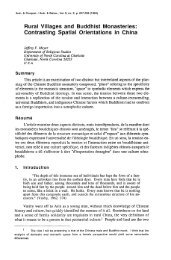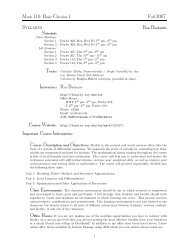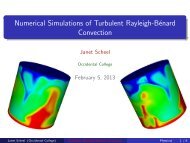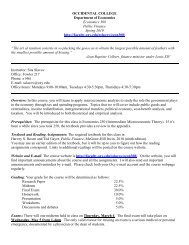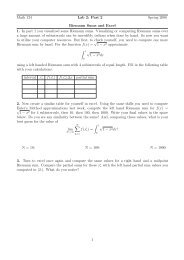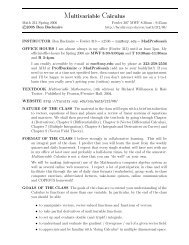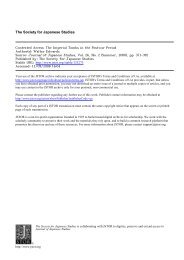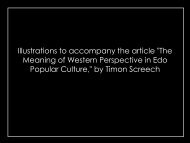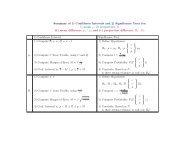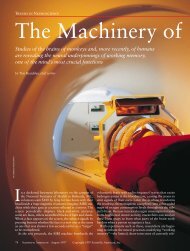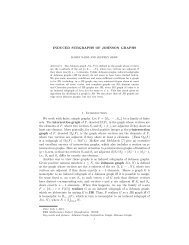Mankiw Chapter 33 and 34 Answers
Mankiw Chapter 33 and 34 Answers
Mankiw Chapter 33 and 34 Answers
Create successful ePaper yourself
Turn your PDF publications into a flip-book with our unique Google optimized e-Paper software.
<strong>Chapter</strong> <strong>33</strong><br />
Questions for Review<br />
3. The aggregate-dem<strong>and</strong> curve is downward sloping because: (1) a decrease in the price<br />
level makes consumers feel wealthier, which in turn encourages them to spend more, so<br />
there is a larger quantity of goods <strong>and</strong> services dem<strong>and</strong>ed; (2) a lower price level reduces<br />
the interest rate, encouraging greater spending on investment, so there is a larger quantity<br />
of goods <strong>and</strong> services dem<strong>and</strong>ed; (3) a fall in the U.S. price level causes U.S. interest<br />
rates to fall, so the real exchange rate depreciates, stimulating U.S. net exports, so there is<br />
a larger quantity of goods <strong>and</strong> services dem<strong>and</strong>ed.<br />
5. Three theories explain why the short-run aggregate-supply curve is upward sloping:<br />
(1) the sticky-wage theory, in which a lower price level makes employment <strong>and</strong><br />
production less profitable because wages do not adjust immediately to the price level, so<br />
firms reduce the quantity of goods <strong>and</strong> services supplied; (2) the sticky-price theory, in<br />
which an unexpected fall in the price level leaves some firms with higher-than-desired<br />
prices because not all prices adjust instantly to changing conditions, which depresses<br />
sales <strong>and</strong> induces firms to reduce the quantity of goods <strong>and</strong> services they produce; <strong>and</strong> (3)<br />
the misperceptions theory, in which a lower price level causes misperceptions about<br />
relative prices, <strong>and</strong> these misperceptions induce suppliers to respond to the lower price<br />
level by decreasing the quantity of goods <strong>and</strong> services supplied.<br />
Problems <strong>and</strong> Applications<br />
2. a. The current state of the economy is shown in Figure 6. The aggregate-dem<strong>and</strong><br />
curve <strong>and</strong> short-run aggregate-supply curve intersect at a point to the left of longrun<br />
aggregate supply.<br />
b. A stock market crash leads to a leftward shift of aggregate dem<strong>and</strong>. The<br />
equilibrium level of output <strong>and</strong> the price level will fall. Since the quantity of<br />
output is less than the natural rate of output, the unemployment rate will rise<br />
above the natural rate of unemployment.<br />
c. If nominal wages are unchanged as the price level falls, firms will be forced to cut<br />
back on employment <strong>and</strong> production. Over time as expectations adjust, the shortrun<br />
aggregate supply curve will shift to the right moving the economy back to the<br />
natural rate of output.
Figure 6<br />
5.<br />
a. The statement that "the aggregate-dem<strong>and</strong> curve slopes downward because it is<br />
the horizontal sum of the dem<strong>and</strong> curves for individual goods" is false. The<br />
aggregate-dem<strong>and</strong> curve slopes downward because a fall in the price level raises<br />
the overall quantity of goods <strong>and</strong> services dem<strong>and</strong>ed through the wealth effect,<br />
the interest-rate effect, <strong>and</strong> the exchange-rate effect.<br />
b. The statement that "the long-run aggregate-supply curve is vertical because<br />
economic forces do not affect long-run aggregate supply" is false. Economic<br />
forces of various kinds (such as population <strong>and</strong> productivity) do affect long-run<br />
aggregate supply. The long-run aggregate-supply curve is vertical because the<br />
price level does not affect long-run aggregate supply.<br />
c. The statement that "if firms adjusted their prices every day, then the short-run<br />
aggregate-supply curve would be horizontal" is false. If firms adjusted prices<br />
quickly <strong>and</strong> if sticky prices were the only possible cause for the upward slope of<br />
the short-run aggregate supply curve, then the short-run aggregate-supply curve<br />
would be vertical, not horizontal. The short-run aggregate supply curve would be<br />
horizontal only if prices were completely fixed.<br />
d. The statement that "whenever the economy enters a recession, its long-run<br />
aggregate-supply curve shifts to the left" is false. An economy could enter a<br />
recession if the aggregate-dem<strong>and</strong> curve or the short-run aggregate-supply curve<br />
shift to the left.
Figure 7<br />
7. If the Fed increases the money supply <strong>and</strong> people expect a higher price level, the<br />
aggregate-dem<strong>and</strong> curve shifts to the right <strong>and</strong> the short-run aggregate-supply curve<br />
shifts to the left, as shown in Figure 7. The economy moves from point A to point B, with<br />
no change in output <strong>and</strong> a rise in the price level (to P 2 ). If the public does not change its<br />
expectation of the price level, the short-run aggregate-supply curve does not shift, the<br />
economy ends up at point C, <strong>and</strong> output increases along with the price level (to P 3 ).<br />
<strong>Chapter</strong> <strong>34</strong><br />
Questions for Review<br />
2. A decrease in the money supply shifts the money-supply curve to the left. The moneysupply<br />
curve now intersects the money-dem<strong>and</strong> curve at a higher interest rate. The<br />
higher interest rate reduces consumption <strong>and</strong> investment, so aggregate dem<strong>and</strong> falls.<br />
Thus, the aggregate-dem<strong>and</strong> curve shifts to the left.<br />
4. If pessimism sweeps the country, households reduce consumption spending <strong>and</strong> firms<br />
reduce investment, so aggregate dem<strong>and</strong> falls. If the Fed wants to stabilize aggregate<br />
dem<strong>and</strong>, it must increase the money supply, reducing the interest rate, which will induce<br />
households to save less <strong>and</strong> spend more <strong>and</strong> will encourage firms to invest more, both of<br />
which will increase aggregate dem<strong>and</strong>. If the Fed does not increase the money supply,<br />
Congress could increase government purchases or reduce taxes to increase aggregate<br />
dem<strong>and</strong>.<br />
Problems <strong>and</strong> Applications<br />
1. a. When the Fed’s bond traders buy bonds in open-market operations, the moneysupply<br />
curve shifts to the right from MS 1 to MS 2 , as shown in Figure 1. The result<br />
is a decline in the interest rate.
Figure 1<br />
b. When an increase in credit card availability reduces the cash people hold, the<br />
money-dem<strong>and</strong> curve shifts to the left from MD 1 to MD 2 , as shown in Figure 2.<br />
The result is a decline in the interest rate.<br />
Figure 2<br />
c. When the Federal Reserve reduces reserve requirements, the money supply<br />
increases, so the money-supply curve shifts to the right from MS 1 to MS 2 , as<br />
shown in Figure 1. The result is a decline in the interest rate.<br />
d. When households decide to hold more money to use for holiday shopping, the<br />
money-dem<strong>and</strong> curve shifts to the right from MD 1 to MD 2 , as shown in Figure 3.<br />
The result is a rise in the interest rate.
Figure 3<br />
e. When a wave of optimism boosts business investment <strong>and</strong> exp<strong>and</strong>s aggregate<br />
dem<strong>and</strong>, money dem<strong>and</strong> increases from MD 1 to MD 2 in Figure 3. The increase in<br />
money dem<strong>and</strong> increases the interest rate.<br />
f. When an increase in oil prices shifts the short-run aggregate-supply curve upward,<br />
the increased price level increases money dem<strong>and</strong>. The money-dem<strong>and</strong> curve<br />
shifts to the right from MD 1 to MD 2 , as shown in Figure 3. The result is a rise in<br />
the interest rate.<br />
6. The dem<strong>and</strong> for net exports is stimulated by expansionary monetary policy through the<br />
exchange-rate effect. The decline in the interest rate increases net capital outflow, thus<br />
increasing net exports.<br />
<strong>Chapter</strong> 3<br />
Questions for Review<br />
1. Absolute advantage reflects a comparison of the productivity of one person, firm, or<br />
nation to that of another, while comparative advantage is based on the relative<br />
opportunity costs of the persons, firms, or nations. While a person, firm, or nation may<br />
have an absolute advantage in producing every good, they can't have a comparative<br />
advantage in every good.<br />
Problems <strong>and</strong> Applications<br />
1. In the text example of the farmer <strong>and</strong> the rancher, the farmer's opportunity cost of<br />
producing one ounce of meat is 4 ounces of potatoes because for every 8 hours of work,<br />
he can produce 8 ounces of meat or 32 ounces of potatoes. With limited time at his<br />
disposal, producing an ounce of meat means he gives up the opportunity to produce 4<br />
ounces of potatoes. Similarly, the rancher's opportunity cost of producing one ounce of<br />
meat is 2 ounces of potatoes because for every 8 hours of work, she can produce 24<br />
ounces of meat or 48 ounces of potatoes. With limited time at her disposal, producing an<br />
ounce of meat means she gives up the opportunity to produce 2 ounces of potatoes.<br />
2. a. See Figure 2. If Maria spends all five hours studying economics, she can read<br />
100 pages, so that is the vertical intercept of the production possibilities frontier.
If she spends all five hours studying sociology, she can read 250 pages, so that is<br />
the horizontal intercept. The time costs are constant, so the production<br />
possibilities frontier is a straight line.<br />
Figure 2<br />
b. It takes Maria two hours to read 100 pages of sociology. In that time, she could<br />
read 40 pages of economics. So the opportunity cost of 100 pages of sociology is<br />
40 pages of economics.<br />
3. a.<br />
Workers needed to make:<br />
One Car<br />
One Ton of Grain<br />
U.S. 1/4 1/10<br />
Japan 1/4 1/5<br />
b. See Figure 3. With 100 million workers <strong>and</strong> four cars per worker, if either<br />
economy were devoted completely to cars, it could make 400 million cars. Since<br />
a U.S. worker can produce 10 tons of grain, if the United States produced only<br />
grain it would produce 1,000 million tons. Since a Japanese worker can produce<br />
5 tons of grain, if Japan produced only grain it would produce 500 million tons.<br />
These are the intercepts of the production possibilities frontiers shown in the<br />
figure. Note that since the tradeoff between cars <strong>and</strong> grain is constant, the<br />
production possibilities frontier is a straight line.
Figure 3<br />
c. Since a U.S. worker produces either 4 cars or 10 tons of grain, the opportunity<br />
cost of 1 car is 2½ tons of grain, which is 10 divided by 4. Since a Japanese<br />
worker produces either 4 cars or 5 tons of grain, the opportunity cost of 1 car is<br />
1 1/4 tons of grain, which is 5 divided by 4. Similarly, the U.S. opportunity cost<br />
of 1 ton of grain is 2/5 car (4 divided by 10) <strong>and</strong> the Japanese opportunity cost of<br />
1 ton of grain is 4/5 car (4 divided by 5). This gives the following table:<br />
Opportunity Cost of:<br />
1 Car (in terms of tons of<br />
grain given up)<br />
1 Ton of Grain (in terms<br />
of cars given up)<br />
U.S. 2 1/2 2/5<br />
Japan 1 1/4 4/5
d. Neither country has an absolute advantage in producing cars, since they're equally<br />
productive (the same output per worker); the United States has an absolute<br />
advantage in producing grain, since it is more productive (greater output per<br />
worker).<br />
e. Japan has a comparative advantage in producing cars, since it has a lower<br />
opportunity cost in terms of grain given up. The United States has a comparative<br />
advantage in producing grain, since it has a lower opportunity cost in terms of<br />
cars given up.<br />
f. With half the workers in each country producing each of the goods, the United<br />
States would produce 200 million cars (that is 50 million workers times 4 cars<br />
each) <strong>and</strong> 500 million tons of grain (50 million workers times 10 tons each).<br />
Japan would produce 200 million cars (50 million workers times 4 cars each) <strong>and</strong><br />
250 million tons of grain (50 million workers times 5 tons each).<br />
g. From any situation with no trade, in which each country is producing some cars<br />
<strong>and</strong> some grain, suppose the United States changed 1 worker from producing cars<br />
to producing grain. That worker would produce 4 fewer cars <strong>and</strong> 10 additional<br />
tons of grain. Then suppose the United States offers to trade 7 tons of grain to<br />
Japan for 4 cars. The United States will do this because it values 4 cars at 10 tons<br />
of grain, so it will be better off if the trade goes through. Suppose Japan changes<br />
1 worker from producing grain to producing cars. That worker would produce 4<br />
more cars <strong>and</strong> 5 fewer tons of grain. Japan will take the trade because it values 4<br />
cars at 5 tons of grain, so it will be better off. With the trade <strong>and</strong> the change of 1<br />
worker in both the United States <strong>and</strong> Japan, each country gets the same amount of<br />
cars as before <strong>and</strong> both get additional tons of grain (3 for the United States <strong>and</strong> 2<br />
for Japan). Thus by trading <strong>and</strong> changing their production, both countries are<br />
better off.<br />
7. a. English workers have an absolute advantage over Scottish workers in producing<br />
scones, since English workers produce more scones per hour (50 vs. 40). Scottish<br />
workers have an absolute advantage over English workers in producing sweaters,<br />
since Scottish workers produce more sweaters per hour (2 vs. 1). Comparative<br />
advantage runs the same way. English workers, who have an opportunity cost of<br />
1/50 sweater per scone (1 sweater per hour divided by 50 scones per hour), have a<br />
comparative advantage in scone production over Scottish workers, who have an<br />
opportunity cost of 1/20 sweater per scone (2 sweaters per hour divided by 40<br />
scones per hour). Scottish workers, who have an opportunity cost of 20 scones<br />
per sweater (40 scones per hour divided by 2 sweaters per hour), have a<br />
comparative advantage in sweater production over English workers, who have an<br />
opportunity cost of 50 scones per sweater (50 scones per hour divided by 1<br />
sweater per hour).<br />
b. If Engl<strong>and</strong> <strong>and</strong> Scotl<strong>and</strong> decide to trade, Scotl<strong>and</strong> will produce sweaters <strong>and</strong> trade<br />
them for scones produced in Engl<strong>and</strong>. A trade with a price between 20 <strong>and</strong> 50<br />
scones per sweater will benefit both countries, as they'll be getting the traded<br />
good at a lower price than their opportunity cost of producing the good in their<br />
own country.<br />
c. Even if a Scottish worker produced just one sweater per hour, the countries would<br />
still gain from trade, because Scotl<strong>and</strong> would still have a comparative advantage
in producing sweaters. Its opportunity cost for sweaters would be higher than<br />
before (40 scones per sweater, instead of 20 scones per sweater before). But there<br />
are still gains from trade since Engl<strong>and</strong> has a higher opportunity cost (50 scones<br />
per sweater).<br />
8. a. With no trade, one pair of white socks trades for one pair of red socks in Boston,<br />
since productivity is the same for the two types of socks. The price in Chicago is<br />
2 pairs of red socks per pair of white socks.<br />
b. Boston has an absolute advantage in the production of both types of socks, since a<br />
worker in Boston produces more (3 pairs of socks per hour) than a worker in<br />
Chicago (2 pairs of red socks per hour or 1 pair of white socks per hour).<br />
Chicago has a comparative advantage in producing red socks, since the<br />
opportunity cost of producing a pair of red socks in Chicago is 1/2 pair of white<br />
socks, while the opportunity cost of producing a pair of red socks in Boston is 1<br />
pair of white socks. Boston has a comparative advantage in producing white<br />
socks, since the opportunity cost of producing a pair of white socks in Boston is 1<br />
pair of red socks, while the opportunity cost of producing a pair of white socks in<br />
Chicago is 2 pairs of red socks.<br />
c. If they trade socks, Boston will produce white socks for export, since it has the<br />
comparative advantage in white socks, while Chicago produces red socks for<br />
export, which is Chicago's comparative advantage.<br />
d. Trade can occur at any price between 1 <strong>and</strong> 2 pairs of red socks per pair of white<br />
socks. At a price lower than 1 pair of red socks per pair of white socks, Boston<br />
will choose to produce its own red socks (at a cost of 1 pair of red socks per pair<br />
of white socks) instead of buying them from Chicago. At a price higher than 2<br />
pairs of red socks per pair of white socks, Chicago will choose to produce its own<br />
white socks (at a cost of 2 pairs of red socks per pair of white socks) instead of<br />
buying them from Boston.<br />
10. a. True; two countries can achieve gains from trade even if one of the countries has<br />
an absolute advantage in the production of all goods. All that's necessary is that<br />
each country have a comparative advantage in some good.<br />
b. False; it is not true that some people have a comparative advantage in everything<br />
they do. In fact, no one can have a comparative advantage in everything.<br />
Comparative advantage reflects the opportunity cost of one good or activity in<br />
terms of another. If you have a comparative advantage in one thing, you must<br />
have a comparative disadvantage in the other thing.<br />
c. False; it is not true that if a trade is good for one person, it can't be good for the<br />
other one. Trades can <strong>and</strong> do benefit both sides⎯especially trades based on<br />
comparative advantage. If both sides didn't benefit, trades would never occur.
<strong>Chapter</strong> 9<br />
Questions for Review<br />
1. If the domestic price that prevails without international trade is above the world price, the<br />
country does not have a comparative advantage in producing the good. If the domestic<br />
price is below the world price, the country has a comparative advantage in producing the<br />
good.<br />
3. Figure 2 illustrates supply <strong>and</strong> dem<strong>and</strong> for an importing country. Before trade is allowed,<br />
consumer surplus is area A <strong>and</strong> producer surplus is area B + C. After trade is allowed,<br />
consumer surplus is area A + B + D <strong>and</strong> producer surplus is area C. The change in total<br />
surplus is an increase of area D.<br />
Figure 2<br />
6. The arguments given to support trade restrictions are: (1) trade destroys jobs; (2)<br />
industries threatened with competition may be vital for national security; (3) new<br />
industries need trade restrictions to help them get started; (4) some countries unfairly<br />
subsidize their firms, so competition isn't fair; <strong>and</strong> (5) trade restrictions can be useful<br />
bargaining chips. Economists disagree with these arguments: (1) trade may destroy<br />
some jobs, but it creates other jobs; (2) arguments about national security tend to be<br />
exaggerated; (3) the government cannot easily identify new industries that are worth<br />
protecting; (4) if countries subsidize their exports, doing so simply benefits consumers in<br />
importing countries; <strong>and</strong> (5) bargaining over trade is a risky business, since it may<br />
backfire, making the country worse off without trade.<br />
Problems <strong>and</strong> Applications<br />
1. a. In Figure 3, with no international trade the equilibrium price is P 1 <strong>and</strong> the<br />
equilibrium quantity is Q 1 . Consumer surplus is area A <strong>and</strong> producer surplus is<br />
area B + C, so total surplus is A + B + C.
Figure 3<br />
b. When the U.S. orange market is opened to trade, the new equilibrium price is P W ,<br />
the quantity consumed is Q D , the quantity produced domestically is Q S , <strong>and</strong> the<br />
quantity imported is Q D – Q S . Consumer surplus increases from A to A + B + D<br />
+ E. Producer surplus decreases from B + C to C. Total surplus changes from A<br />
+ B + C to A + B + C + D + E, an increase of D + E.<br />
2. a. Figure 4 illustrates the U.S. market for wine, where the world price of wine is P 1 .<br />
The following table illustrates the results under the heading "P 1 ."<br />
P 1 P 2 CHANGE<br />
Consumer Surplus A+B+D+E A+D –(B+E)<br />
Producer Surplus C B+C +B<br />
Total Surplus A+B+C+D+<br />
E<br />
A+B+C+D –E
Figure 4<br />
b. The shift in the Gulf Stream destroys some of the grape harvest, raising the world<br />
price of wine to P 2 . The table shows the effects on consumer, producer, <strong>and</strong> total<br />
surplus, under the heading "P 2 " <strong>and</strong> the change in the surplus measures under the<br />
heading "CHANGE." Consumers lose, producers win, <strong>and</strong> the United States as a<br />
whole is worse off.<br />
3. Figure 5 shows the market for cotton in countries A <strong>and</strong> B. Note that the world price of<br />
cotton is the same in both countries. Country A imports cotton from country B. The<br />
table below shows that total surplus is higher in both countries. However, in country A,<br />
consumers are better off <strong>and</strong> producers are worse off, while in country B, consumers are<br />
worse off <strong>and</strong> producers are better off.<br />
Figure 5
COUNTRY A<br />
Before Trade After Trade CHANGE<br />
Consumer Surplus C C+D+F +(D+F)<br />
Producer Surplus D+E E –D<br />
Total Surplus C+D+E C+D+E+F +F<br />
COUNTRY B<br />
Before Trade After Trade CHANGE<br />
Consumer Surplus G+H G –H<br />
Producer Surplus I H+I+J +(H+J)<br />
Total Surplus G+H+I G+H+I+J +J<br />
4. The impact of a tariff on imported autos is shown in Figure 6. Without the tariff, the<br />
price of an auto is P W , the quantity produced in the United States is Q 1 S , <strong>and</strong> the quantity<br />
purchased in the United States is Q 1 D . The United States imports Q 1 D – Q 1 S autos. The<br />
imposition of the tariff raises the price of autos to P W + t, causing an increase in quantity<br />
supplied by U.S. producers to Q 2 S <strong>and</strong> a decline in the quantity dem<strong>and</strong>ed to Q 2 D , thus<br />
reducing the number of imports to Q 2 D – Q 2 S . The table shows the impact on consumer<br />
surplus, producer surplus, government revenue, <strong>and</strong> total surplus both before (OLD) <strong>and</strong><br />
after (NEW) the imposition of the tariff, as well as the change (CHANGE). Since<br />
consumer surplus declines by C+D+E+F while producer surplus rises by C <strong>and</strong><br />
government revenue rises by E, the deadweight loss is D+F. The loss of consumer<br />
surplus in the amount C+D+E+F is split up as follows: C goes to producers, E goes to the<br />
government, <strong>and</strong> D+F is deadweight loss.<br />
Figure 6
Before Tariff After Tariff CHANGE<br />
Consumer Surplus A+B+C+D+E+F A+B –<br />
(C+D+E+F)<br />
Producer Surplus G C+G +C<br />
Government 0 E +E<br />
Revenue<br />
Total Surplus<br />
A+B+C+D+E+F+<br />
G<br />
A+B+C+E+<br />
G<br />
–(D+F)<br />
5. a. The world wheat price must be below the U.S. no-trade price, because wheat<br />
farmers oppose NAFTA. They oppose it because they know that when trade is<br />
allowed, the U.S. price of wheat will decline to the world price, <strong>and</strong> their producer<br />
surplus will fall. The world corn price must be above the U.S. no-trade price,<br />
since corn farmers support NAFTA. They know that when trade is allowed, the<br />
U.S. price of corn will rise to the world price, <strong>and</strong> their producer surplus will rise.<br />
b. Considering both markets together, NAFTA makes wheat farmers worse off <strong>and</strong><br />
corn farmers better off, so it isn't clear whether farmers as a whole gain or lose.<br />
Similarly, consumers of wheat gain (since the price of wheat will decline) <strong>and</strong><br />
consumers of corn lose (since the price of corn will rise), so consumers as a whole<br />
may either gain or lose. However, we know that the total gains from trade are<br />
positive, so the United States as a whole is better off.<br />
10. Selling the licenses at auction is the policy with the lowest deadweight loss, since the<br />
licenses go to those who value them the most. In addition, the government gets revenue<br />
from selling the licenses, so it can reduce taxes elsewhere, lowering deadweight loss from<br />
other taxes. The largest deadweight loss probably goes to the policy of waiting in line for<br />
the licenses, since people incur the loss of time in waiting, which is a deadweight loss. If<br />
people can then sell the licenses, they'll go to those who value them most highly;<br />
however, the government will get no revenue, <strong>and</strong> will not be able to reduce taxes<br />
elsewhere. The policy with the middle amount of deadweight loss is the policy of<br />
distributing licenses r<strong>and</strong>omly. It does not have the deadweight loss associated with<br />
people st<strong>and</strong>ing in line, but does not raise revenue like the policy of selling the licenses.<br />
11.a.<br />
Figure 9 illustrates the effects of a quota in the U.S. sugar market. The domestic supply<br />
curve is denoted S. If there were no quota, the total supply curve would be along curve S<br />
for quantities from 0 to Q 1 S (representing domestic production) <strong>and</strong> would be horizontal<br />
at P W (the world price of sugar) for higher quantities, representing imports of sugar. The<br />
result is that the equilibrium quantity supplied by domestic producers is Q 1 S , the<br />
equilibrium quantity dem<strong>and</strong>ed is Q 1 D , imports are Q 1 D – Q 1 S , <strong>and</strong> the price is P W .<br />
When the quota is introduced, the total supply curve is the same as without the quota up<br />
to the quantity Q 1 S + quota, then follows the curve S + quota for higher quantities. The<br />
quota limits the quantity of imports of sugar, leading to equilibrium at price P q . The<br />
result is that the equilibrium quantity supplied by domestic producers is Q 2 S , the<br />
equilibrium quantity dem<strong>and</strong>ed is Q 2 D , <strong>and</strong> imports are Q 2 D – Q 2 S , which equals the<br />
quota.
Figure 9<br />
b. The following table illustrates the effects of the quota on sugar on welfare. The<br />
gains to license-holders may accrue to private parties if the government gives the<br />
quota licenses away, or to the government if the licenses are sold.<br />
Without Quota With Quota CHANGE<br />
Consumer<br />
Surplus<br />
A+B+C+D+E'+E"+F A+B -<br />
(C+D+E'+E"+F<br />
)<br />
Producer Surplus G C+G +C<br />
License Holders 0 E'+E" +E'+E"<br />
Total Surplus A+B+C+D+E'+E"+F<br />
+G<br />
A+B+C+E'+E"<br />
+G<br />
-(D+F)<br />
c. Gains <strong>and</strong> losses in other countries could be important, since trade can improve<br />
the welfare of all nations. In addition, it is not clear that we should be in cutthroat<br />
competition with other countries; we may care about people throughout the world.<br />
d. The higher sugar prices caused by the quota system have had an impact on the<br />
fructose syrup industry since fructose is a substitute for sugar. With a higher<br />
sugar price, people substitute fructose for sugar, so the fructose industry exp<strong>and</strong>s.



